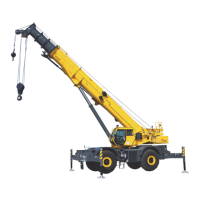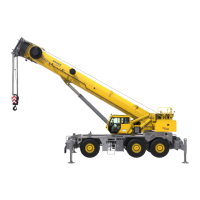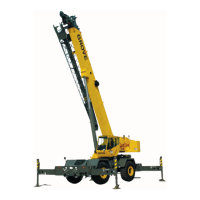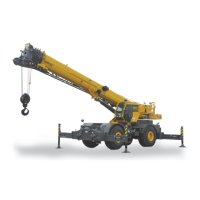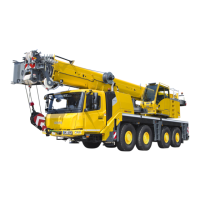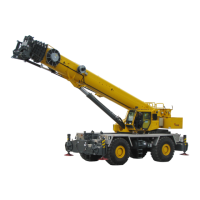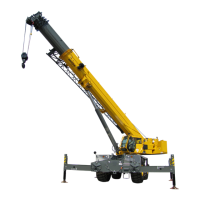OPERATING PROCEDURES GRT8120 OPERATOR MANUAL
4-14 Published 3-22-2021, Control # 702-02
• Make sure boom is in a horizontal position and not
elevated above 0°.
• Make sure outrigger beams and jacks are fully retracted
with pads properly stowed.
To avoid severe damage to drivetrain while crane engine is
disabled:
• Disconnect drivelines if towing crane for more than 75 m
(250 ft).
• Disengage parking brake by manually turning parking
brake adjustment until axle turns free.
• Secure steering to prevent turning while towing.
• Conduct all travel with assistance of a ground person to
warn operator of any changing conditions in terrain
being traversed.
Traveling on Slopes
Crane operators must exercise caution whenever operating
the crane on uneven surfaces. Travel on slopes is permitted
if the following conditions are met.
General Conditions
• Travel must be on an improved surface or hard-packed
dry earth. Crane operators are required to inspect the
surface for good tire adhesion.
• Do not exceed a speed of 1.6 km/h (1 mph).
• Limit travel to a forward direction only.
• All boom sections must be fully retracted.
• Boom extension must be in stowed position or removed
from the crane (if traveling with an erected boom
extension, follow the requirements under the section
Traveling with Boom Extension Erected, page 4-15).
• Lower boom to horizontal and position over front of
crane.Swing brake must be applied and turntable lock
pin engaged.
• Either the hook block may be reeved over the main
boom nose, or the overhaul ball may be reeved over the
main boom nose or auxiliary boom nose; the other must
be removed. If hook block or overhaul ball remains
reeved on the boom, it must be secured at the tie down
on the carrier to prevent swinging.
• Tires must be inflated to the recommended pressure
indicated in the Load Chart Manual.
• Hydraulic tank must be filled to specified level. Fuel tank
must be over half full.
• Engine and transmission fluids must be filled to the
specified levels.
• Axle differentials and planetary hub fluids must be filled
to the specified levels.
• No loads may be supported by the boom (i.e., no pick
and carry loads) while traversing a slope.
• All cribbing or other non-standard accessories must be
removed from the crane.
• Avoid holes, rocks, extremely soft surfaces, and any
other obstacles that might subject crane to undue
stresses and possible overturn.
• Operator is to check for changing road conditions and
utilize a ground person if deemed necessary.
Slope Limitations – Fore/Aft Travel
• When traversing a fore/aft slope that is less than or
equal to 15% (8.5°), follow the normal crane travel
procedures outlined in this manual.
• When traversing a fore/aft slope that is greater than 15%
(8.5°) and less than 25% (14°), shift transmission to
four-wheel drive and limit travel speed to 1.6 km/h
(1 mph). If crane must be parked, make sure the
transmission is in 4-wheel drive and the wheels are
chocked.
• When traversing a fore/aft slope that is equal to or
greater than 25% (14°), use an assist vehicle and shift
the crane’s transmission to four-wheel drive. Do not park
crane on a slope equal to or greater than 25% (14°).
• Travel on a fore/aft slope up to 30% (16°), such as
ramps, is permitted for short distances at low speed.
CAUTION
Machine Damage Hazard!
It is recommended to attach cables/straps to the optional
pintle hook (if equipped) or by attaching at a point no
higher than the pintle hook height if being towed by
another vehicle.
Do not attach to the tie-down lugs unless the attaching
point is no higher than the pintle hook height.
Should the crane become mired down, use a tow truck or
tractor to free the vehicle. Severe damage to the
drivetrain may occur if the operator attempts to free the
crane unassisted.
DANGER
Run-away Crane Hazard!
Disabling parking brake may result in crane rolling away
freely without the ability of the operator to stop the crane.
Make sure that the crane is attached to an adequately
sized tow vehicle before disabling the parking brake.
Death or serious injury and damage to machinery could
result from moving machinery.
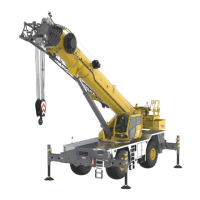
